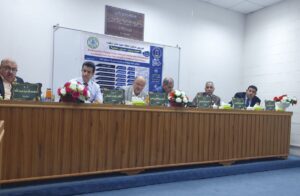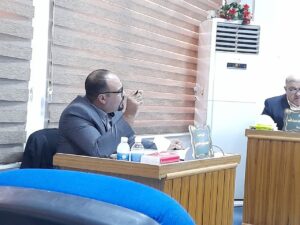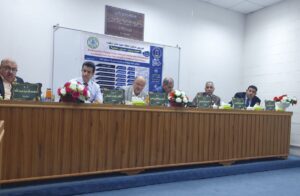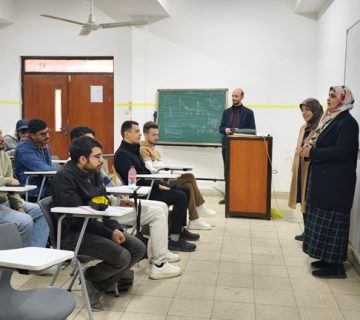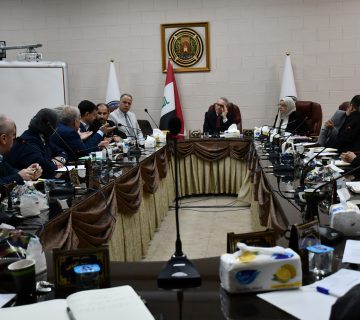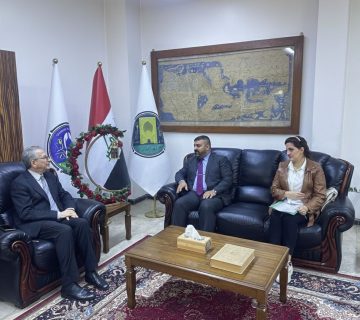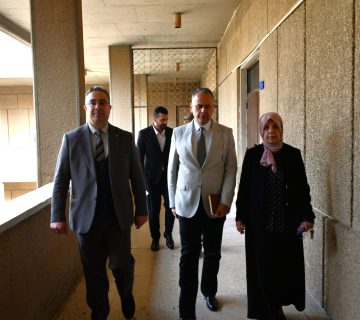It was conducted on Thursday, 4/5/2023, in the meeting hall the discussion of the doctoral dissertation of the student Ahmed Walid Hussein, which is tagged: “Enhancement of Sliding Contact Behaviour and Dynamic Characteristics in a Parallel Axes Gear Pair Using Non-Traditional Teeth Shapes“.
The discussion committee consisted of names listed below:
Prof. Dr. Muhsin J. Jweeg – Al-Farahidi University – Chairman.
Prof. Dr. Ahmed Abdul Hussein Ali – University of Baghdad / College of Engineering / Department of Mechanical Engineering – Member.
Prof. Dr. Muhsin A. Al-Shammari – University of Baghdad / College of Engineering / Department of Mechanical Engineering – Member.
Asst. Prof. Dr. Thaier J. Ntayeesh – University of Baghdad/ College of Engineering/ Department of Mechanical Engineering– Member.
Asst. Prof. Dr. Nassear Rasheid Hmood – University of Baghdad/ College of Engineering/ Aeronautical Department – Member.
Prof. Dr. Mohammad Q. Abdullah – University of Baghdad/ College of Engineering/ Department of Mechanical Engineering– Supervisor.
The dissertation was summarized as follows:
The main aim of the study is to construct and test a new non-involute gear tooth profile that, compared to the standard involute tooth profile, can improve the meshing performance of a spur gear pair through a convex-concave contact interaction. The purpose of the suggested new tooth profile is to mitigate the disadvantages of the involute gear in terms of sliding contact behavior and minimum number of teeth to avoid the interference. The study is characterized by three parts: The first part of the study was the analytical investigation. In this part, a generalized mathematical model for defining the gear tooth profile has been constructed based on a pre-definition of a multi-segment path of contact (POC). The second part of this study is the finite element simulation. In this study, ABAQUS, a finite element analysis tool, was used to conduct a 2D finite element analysis (FEA) to validate the analytical and experimental results for various contact design scenarios. Furthermore, the FEA was utilized to evaluate the tooth mesh stiffness and fillet stress for each gear type analyzed. The experimental work is the third part of this study. In the first section of this part, an effective technique based on photoelastic testing and a numerical approach was developed in order to analyze the contact zone variables for a gear pair made of photosensitive material. Using this technique, the maximum contact and fillet stresses for the tested gear were evaluated. In the second section of this part, the experimental dynamic behavior of the tested gears was examined in terms of noise, vibration, and the oil temperature in the gearbox at different speeds and loads. The design methodology has been applied to special case studies in which extreme meshing conditions are present. The results showed that the approach suggested in this work might be used to construct a gear tooth profile that has improved contact and fillet strengths, a lower sliding ration, and thus enhanced durability compared to an involute gear. The results also showed that the proposed design methodology is capable of constructing gears with a number of teeth less than the minimum number of teeth of the involute gear without interference limitations.
After scientific discussions by the discussion committee members on the contents of the dissertation in-depth and expressing their observations, directives, and defense by the student, the dissertation was accepted and the student was awarded the Ph.D. in mechanical engineering sciences with a grade of excellent.
On this occasion, we cannot help but extend our thanks to the student, Ahmed Walid Hussein, for his outstanding efforts throughout the study period, wishing him continued success. We also thank the supervisor and the discussion committee members, for their tireless and distinguished effort, in a way that befits the submission of the dissertation in the best way and in accordance with the scientific level presented.
